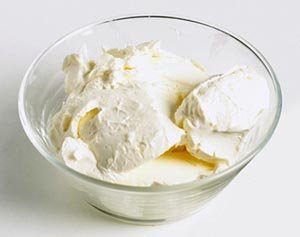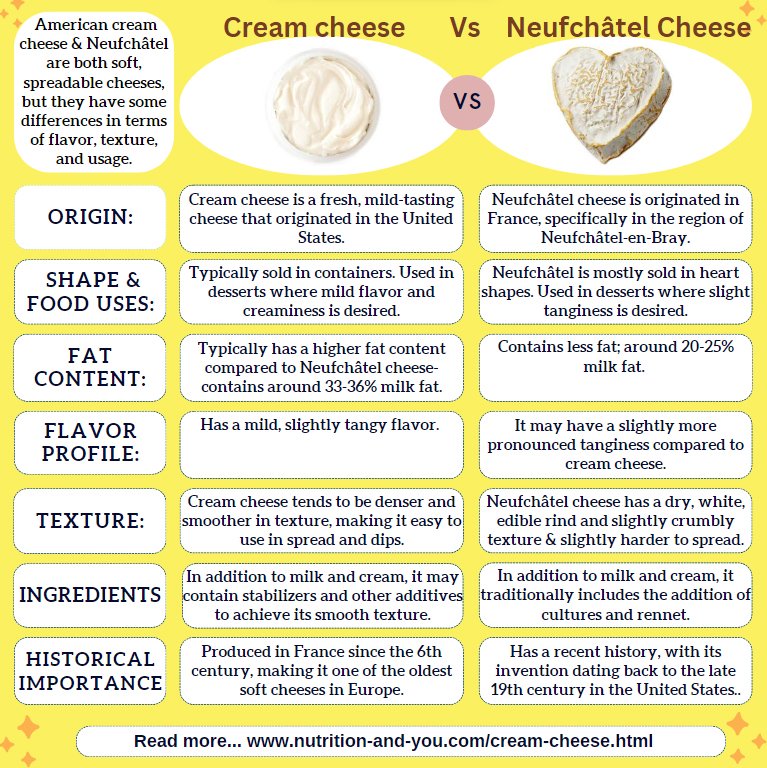American Cream cheese nutrition facts
Cheesecake, the ultimate dessert choice for any occasion, uses cream cheese as its foundational ingredient! Crafted from fresh cow's milk, this soft, slightly tangy dairy delight boasts a smooth, spreadable texture, rich in milk solids.
The USDA advises that standard cream cheese should contain at least 33% total fats, approximately 10% proteins, and around 55% moisture content. 1 gallon of fresh milk will yield 1.5 to 2 lbs. of cream cheese.
 |
| Fresh cream cheese. |
Processing of Cream cheese:
Preparing cream cheese and similar soft cheeses at home is a straightforward process that requires only basic utensils, a cheesecloth, and minimal effort.
Typically, rural dairy farmers utilize surplus milk to craft various cheeses, such as cream cheese. Alternatively, certain commercial establishments opt to utilize either pure cream or a blend of milk and cream in their cream cheese production.
To achieve high-quality cream cheese, it's essential to use thoroughly cleaned and sterilized equipment. Other prerequisites are- fresh pasteurized milk or sweet cream along with natural additives like mesophilic culture, containing the necessary bacteria for lactose conversion to lactic acid, and vegetable rennet, which aids in milk coagulation. Alternatively, cultured buttermilk can serve as an effective mesophilic culture.
First, warm the milk to 70 - 80° F in a stainless steel container. Add 50 ml of cultured buttermilk or one sachet of commercial mesophilic starter culture to each gallon of milk. Stir well, cover the bowl, and allow the starter-inoculated mixture to sit undisturbed for an hour at room temperature.
In the next step, dilute the vegetable rennet in half a cup of cold water and stir well. Add this mixture to the inoculated milk. Stir well to ensure the rennet is evenly distributed in the milk. Cover the container with a lid and leave it undisturbed for 24 hours until the whey (a thin, yellowish liquid) separates and curd forms.
When the product turns sour and thoroughly coagulated, stir it gently to break up the curd. Heat the "set" again to 110°F to separate the whey from the curd and to speed up the subsequent draining and pressing. Once whey separation is achieved, pour it into a cheesecloth to drain. Press until the curd has attained a fine, paste-like consistency.
Transfer cream cheese into a bowl and add salt at the rate of 1 tsp. to each pound. Mix thoroughly, and store in the refrigerator.
Neufchâtel cheese
Neufchâtel cheese is the lighter version of cream cheese. It contains between 20% and 23% total fats, and not more than 65% moisture. It normally contains about 18% protein.
p>See the differences between Cream cheese and Neufchâtel cheese in an infographic:
 |
Nutrition Facts and Health Benefits of Cream Cheese
American cream cheese is a nutritionally complete food since it contains almost all the nutrients including vitamin-B12. 100g cream cheese has 350 calories and 34 g of total fat.
Cream cheese contains a small amount of lactose (1 g/oz) making it one of the dietary sources of calcium for those with lactose intolerance. Almost all the naturally occurring lactose within cow milk is converted into more easily digestible lactic acid while making it.
Cream cheese, being a dairy product, is free of gluten. In gluten-sensitive (Celiac disease) persons, it is another important source of gluten-free food items rich in protein, minerals, and vitamins.
During the curdling process, key components of milk, including lactose, milk lipids, and milk proteins, undergo biochemical transformations into products that are not only more easily digestible but also offer health benefits.
In a way similar to cheddar cheese, it serves as an excellent source of dietary calcium and phosphorus. Alongside vitamin D, cheese contributes significantly to the growth and development of children's health.
Cream cheese offers a high-quality protein source abundant in all essential amino acids required for growth, development, and overall health maintenance. Approximately 100 grams of cream cheese contains 6-10 grams of protein.
It is a very good source of fat-soluble vitamins, especially vitamin A. 100g of aged Cream contains 1,111 IU (37% of RDI) of this vitamin.
Further, it is an optimal source of minerals, especially calcium (10% of RDI), phosphorus (15% of RDI), zinc (4% of RDI), and magnesium.
| Principle | Nutrient Value | Percent of RDA |
|---|---|---|
| Energy | 350 Kcal | 4% |
| Carbohydrates | 5.52g | 4% |
| Protein | 6.15g | 11% |
| Total Fat | 34.44g | 172% |
| Dietary Fiber | 0 g | 0% |
| Vitamins | ||
| Folates | 9 μg | 2.25% |
| Niacin | 0.091 mg | <1% |
| Pyridoxine | 0.056 mg | 4% |
| Riboflavin | 0.23 mg | 18% |
| Thiamin | 0.023 mg | 2% |
| Vitamin-A | 1111 IU | 37% |
| Vitamin-B12 | 0.22 μg | 9% |
| Vitamin-C | 0 mg | 0% |
| Vitamin-D | 0 IU | 0% |
| Vitamin-E | 0.86 mg | 6% |
| Vitamin K | 2.1 µg | 2% |
| Electrolytes | ||
| Sodium | 314 mg | 21% |
| Potassium | 132 mg | 2.8% |
| Minerals | ||
| Calcium | 97 mg | 10% |
| Copper | 0.018 mg | 2% |
| Iron | 0.11 mg | 1.4% |
| Magnesium | 9 mg | 2% |
| Manganese | 0.011 mg | <1% |
| Phosphorus | 107 mg | 15% |
| Zinc | 0.5 mg | 4% |
Buying
Fresh cream cheese variants; full fat, reduced fat, lite, other foods added, etc can be readily available year-round in grocery stores and dairy parlors.
While buying, look for cream cheese with a smooth, consistent white to light cream color, devoid of any lumps or grittiness. Reduced-fat cream cheese may exhibit a slightly pasty texture. If incorporating other ingredients, ensure they are evenly distributed, imparting the desired characteristic color to the final product. Additionally, inspect the cheese for any visible mold or surface discolorations.
Avoid selecting cream cheese with excessive whey running from the margins. Opt for cheese that is medium-firm when cold yet spreadable at room temperature.
Storing
Due to its delicate nature as a dairy product, cream cheese is highly perishable. If you prepare it at home, it's advisable to make small batches and store it well in the fridge for up to a week.
Food uses
Cream cheese is best enjoyed fresh and should be eaten quickly. It serves as a highly convenient and versatile dairy ingredient that chefs love to work with in a myriad of mouth-watering desserts and savory recipes. It pairs well with fruits and vegetables.
In cooking, cream cheese proves useful in savory recipes such as chicken or vegetable stuffing, dips, sauces, and soups. However, its primary application lies in serving as a delectable topping or spread for numerous desserts, including cakes, donuts, and bagels, as well as being cream-filled or stuffed into bread, croquettes, muffins, cookies, and more.
Here are some serving tips
 |
| Blackberries cheesecake. Courtesy: Marco Verch |
Use cream cheese as a substitute in recipes that traditionally call for ingredients like butter, cream, Greek yogurt, mayonnaise, and more.
Employ it as a base ingredient in delicious Philadelphia cherry pie and cheesecakes.
Blend fruit yogurt and cream cheese to create mouth-watering fruit dips.
Thoroughly mix cream cheese and butter until creamy to prepare cream cheese frosting for use as decorative toppings in confectionery.
As a soft cheese, it can be substituted for Neufchatel, cottage, etc., to prepare pasta sauce.
Safety profile
Cream cheese is a nutritious, low-sodium, and low in saturated fats dairy item, unlike other hard cheeses like cheddar. For these reasons, it is considered one of the healthy choices for people who are on a low-sodium and low-fat diet program.
Skim-milk cream cheese contains small amounts of tyramine and can be eaten in small quantities by those on the tyramine-restricted diet.
Source: Queensland Government-low tyramine diet: MAOI's and diet.
Also read ≻≻-
≺≺ -Understanding Lactose Intolerance and How to Manage It
≺≺ -Paneer (Indian cottage cheese) nutrition facts.
≺≺ -Cheddar cheese nutrition facts.
≻≻- Back to Dairy products from Cream cheese nutrition facts.
≻≻- Back to Home page.
Further Resources:
USDA National Nutrient Database. (opens in new window).
USDA Specifications for Cream Cheese, Cream Cheese with other Foods, and Related Products. (opens in new window).
Queensland Governament- low tyramine diet..
University of Verginia Health System Lactose Content of Common Dairy Foods